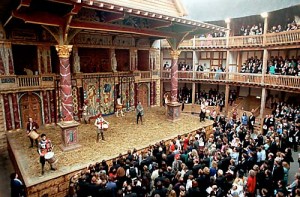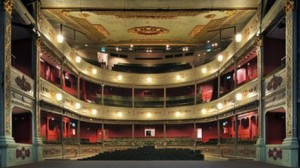Who invented the “Shakespearean theatre”? Burbage and Shakespeare and/or Henslowe and Alleyn? This is the title of a one-day conference being held at the University of Reading this Saturday coming, 24 November.
Because Shakespeare is now the most famous playwright from the period we tend to think he dominated the theatre world of the late sixteenth and early seventeenth centuries. But was this true? The conference will discuss the Shakespearean theatres as physical entities as well as the plays and theatre practices which went on in them. Were Burbage and Shakespeare really in competition with Henslowe and Alleyn or was the relationship more complicated? And what about the other companies about which we know less?
The conference is organised by Professor Grace Ioppolo and brings together some of the most important people in the field, including senior academics Reg Foakes, Andrew Gurr and Stanley Wells, members of the Museum of London Archaeology team who have excavated the remains of many of the theatres, and other leading scholars. It’s aimed not just at academics and students but also at actors, directors and theatre aficionados. Registration is about to close so get your skates on if you want to be there. If you can’t make it, here’s a link to a podcast from the National Archives by Grace Ioppolo on a similar subject.
And the Henslowe-Alleyn digitisation project is a great resource for digital information on the subject.
On the subject of Shakespearean theatres, it’s just been announced that Lottery funding has been awarded to a project aiming to draw up plans for further excavations of the Rose Theatre site and to plan the delivery of educational resources and performances.
In an unexpected development, a link has been drawn between Shakespearean theatres like the Rose and another theatre which is currently being restored, the Bristol Old Vic.
This building dates from the mid-eighteenth century and is the oldest functioning theatre in existence. The exploration has found that originally, like theatres in the Shakespeare period, it had a thrust stage. It has always been thought that once theatres moved inside and adopted the use of lighting and scenery a picture-frame or proscenium arch stage was developed. The thrust stage encourages much more audience participation and it seems that the atmosphere was more like “a speakeasy or nightclub”. It’s known that the audience for Shakespeare’s theatre could be rowdy but it appears that this may have continued much longer than had been thought. This discovery may in itself cause a reassessment of theatres in the eighteenth century. Technical information is in this article from Lighting and Sound International.
For anyone interested in the history of theatres in the UK, I’d recommend the Theatres Trust website. This organisation aims to protect the UK’s theatres and to champion their future. And they’re also interested in what makes a good theatre. To that end its website includes a database of theatres, an image library, information about the history of theatres and theatre decoration, stages and auditoria. There are also a series of downloadable resource sheets for teachers.





I would have thought this was fairly obvious; the Shakespearean theatre was a chance consequence of the cultural, political and economic conditions of the time and those of earlier times. It was not invented, but evolved over centuries.
Thanks for your comment. I’m going to be writing something about the conference next week, I hope!
BRISTOL OLD VIC RENOVATION.
Some real discoveries here, some not so new. The orginal procscenium door onto the stage is a great find, and the sailor’s drawing reaffirming the link between sailors and the flymen. The thunder roll is not os new I believe.
That traces of the original stage have been found is exciting. However, I’m not so sure about the claim about what happened to thrust stages when theatres came indoors, introduced by ‘ It has always been thought…’ . There is evidence from many prints of thrust stages, although not necessarily halfway into the auditorium. Most of the light was in the auditorium so that’s where the actors could be seen. Slotted scenery flats were partly for atmosphere and decoration although wing lights were introduced, enabling soem action upstage. Although David Garrick brought footlights from the Continent they were not an instant success. It was the theatre managers who started hacking away at the forestage as a way of increasing the take on the house.
Thanks for all this additional information!I had no idea the reason for reducing the size of the stage was to do with increasing audience numbers and hence income!
The Globe Theatre page of Shake Sphere (www.shakespearestudyguide.com) provides detailed information on the development of the Shakespeare theatre.
Thanks for your useful comment!